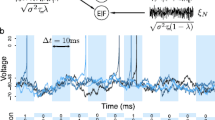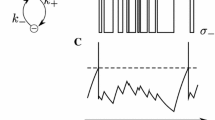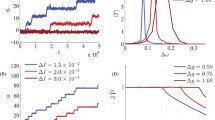Abstract
Step changes in input current are known to induce partial phase synchrony in ensembles of leaky integrate-and-fire neurons operating in the oscillatory or “regular firing” regime. An analysis of this phenomenon in the absence of noise is presented based on the probability flux within an ensemble of generalized integrate-and-fire neurons. It is shown that the induction of phase synchrony by a step input can be determined by calculating the ratio of the voltage densities obtained from fully desynchronized ensembles firing at the pre and post-step firing rates. In the limit of low noise and in the absence of phase synchrony, the probability density as a function of voltage is inversely proportional to the time derivative along the voltage trajectory. It follows that the magnitude of phase synchronization depends on the degree to which a change in input leads to a uniform multiplication of the voltage derivative over the range from reset to spike threshold. This analysis is used to investigate several factors affecting phase synchronization including high firing rates, inputs modeled as conductances rather than currents, peri-threshold sodium currents, and spike-triggered potassium currents. Finally, we show that without noise, the equilibrium ensemble density is proportional to the phase response curve commonly used to analyze oscillatory systems.
Similar content being viewed by others
References
Amari S (1974) A method of statistical neurodynamics. Kybernetik 14(4): 201–215.
Brown E, Moehlis J, Holmes P (2004a) On the phase reduction and response dynamics of neural oscillator populations. Neural Comput. 16(4): 673–715.
Brown E, Moehlis J, Holmes P, Clayton E, Rajkowski J, Aston-Jones G (2004b) The influence of spike rate and stimulus duration on noradrenergic neurons. J. Comput. Neurosci. 17(1): 13–29.
Brunel N (2000) Dynamics of sparsely connected networks of excitatory and inhibitory spiking neurons. J. Comput. Neurosci. 8(3): 183–208.
Ermentrout B (1996) Type I membranes, phase resetting curves, and synchrony. Neural Comput. 8(5): 979–1001.
Ermentrout B, Kopell N (1986) Symmetry and phaselocking in chains of weakly coupled oscillators. Comm. Pure Appl. Math. 39(5): 623–660.
Fourcaud-Trocme N, Brunel N (2005) Dynamics of the instantaneous firing rate in response to changes in input statistics. J. Comput. Neurosci. 18(3): 311–321.
Fourcaud-Trocme N, Hansel D, van Vreeswijk C, Brunel N (2003) How spike generation mechanisms determine the neuronal response to fluctuating inputs. J. Neurosci. 23(37): 11628–11640.
Gerstner W (2000) Population dynamics of spiking neurons: Fast transients, asynchronous states, and locking. Neural Comput. 12(1): 43–89.
Gerstner W, Kistler W (2002) Spiking Neuron Models. Cambridge Univ. Press, Cambridge, UK.
Gutkin B, Ermentrout G, Reyes A (2005) Phase-response curves give the responses of neurons to transient inputs. J. Neurophysiol. 94: 1623–1635.
Hansel D, Mato G, Meunier C (1995) Synchrony in excitatory neural networks. Neural Comput. 7(2): 307–337.
Hermann A, Gerstner W (2001) Noise and the PSTH response to current transients: I. General theory and application to the integrate-and-fire neuron. J. Comput. Neurosci. 11(2): 135–151.
Hoppensteadt F, Izhikevich E (1997) Weakly Connected Neural Networks. Springer, New York.
Izhikevich E (2003) Simple model of spiking neurons. IEEE Trans. Neural Networks 14: 1569–1572.
Knight B (1972) Dynamics of encoding in a population of neurons. J. Gen. Physiol. 59(6): 734–766.
Knight B, A, A. O, Sirovich L (2000) The approach of a neuron population firing rate to a new equilibrium: An exact theoretical result. Neural Comput. 12(5): 1045–1055.
Latham P, Richmond B, Nelson P, Nirenberg S (2000) Intrinsic dynamics in neuronal networks. I. Theory. J. Neurophysiol. 83: 808–827.
Madison D, Nicoll R (1984) Control of the repetitive discharge of rat CA1 pyramidal neurones in vitro. J. Physiol. 354: 319–331.
Moreno-Bote R, Parga N (2005) Membrane potential and response properties of populations of cortical neurons in the high conductance state. Phys. Rev. Lett. 94: 088103.
Naundorf B, Geisel T, Wolf F (2005) Action potential onset dynamics and the response speed of neuronal populations. J. Comput. Neurosci. 18(3): 297–309.
Nykamp D, Tranchina D (2000) A population density approach that facilitates large-scale modeling of neural networks: Analysis and an application to orientation tuning. J. Comput. Neurosci. 8(1): 19–50.
Omurtag A, Knight B, Sirovich L (2000) On the simulation of large populations of neurons. J. Comput. Neurosci. 8(1): 51–63.
Riccardi L (1977) Diffusion Processes and Related Topics in Biology. Springer-Verlag.
Salinas E, Sejnowski T (2001) Correlated neuronal activity and the flow of neural information. Nat. Rev. Neurosci. 2(8): 539–550.
Stein R (1965) A theoretical analysis of neuronal variability. Biophys. J. 91: 173–94.
Wilson H, Cowan J (1972) Excitatory and inhibitory interactions in localized populations of model neurons. Biophys. J. 12(1): 1–24.
Author information
Authors and Affiliations
Corresponding author
Additional information
Action Editor: John Rinzel
Rights and permissions
About this article
Cite this article
Troyer, T.W. Factors affecting phase synchronization in integrate-and-fire oscillators. J Comput Neurosci 20, 191–200 (2006). https://doi.org/10.1007/s10827-006-6174-6
Received:
Revised:
Accepted:
Published:
Issue Date:
DOI: https://doi.org/10.1007/s10827-006-6174-6




